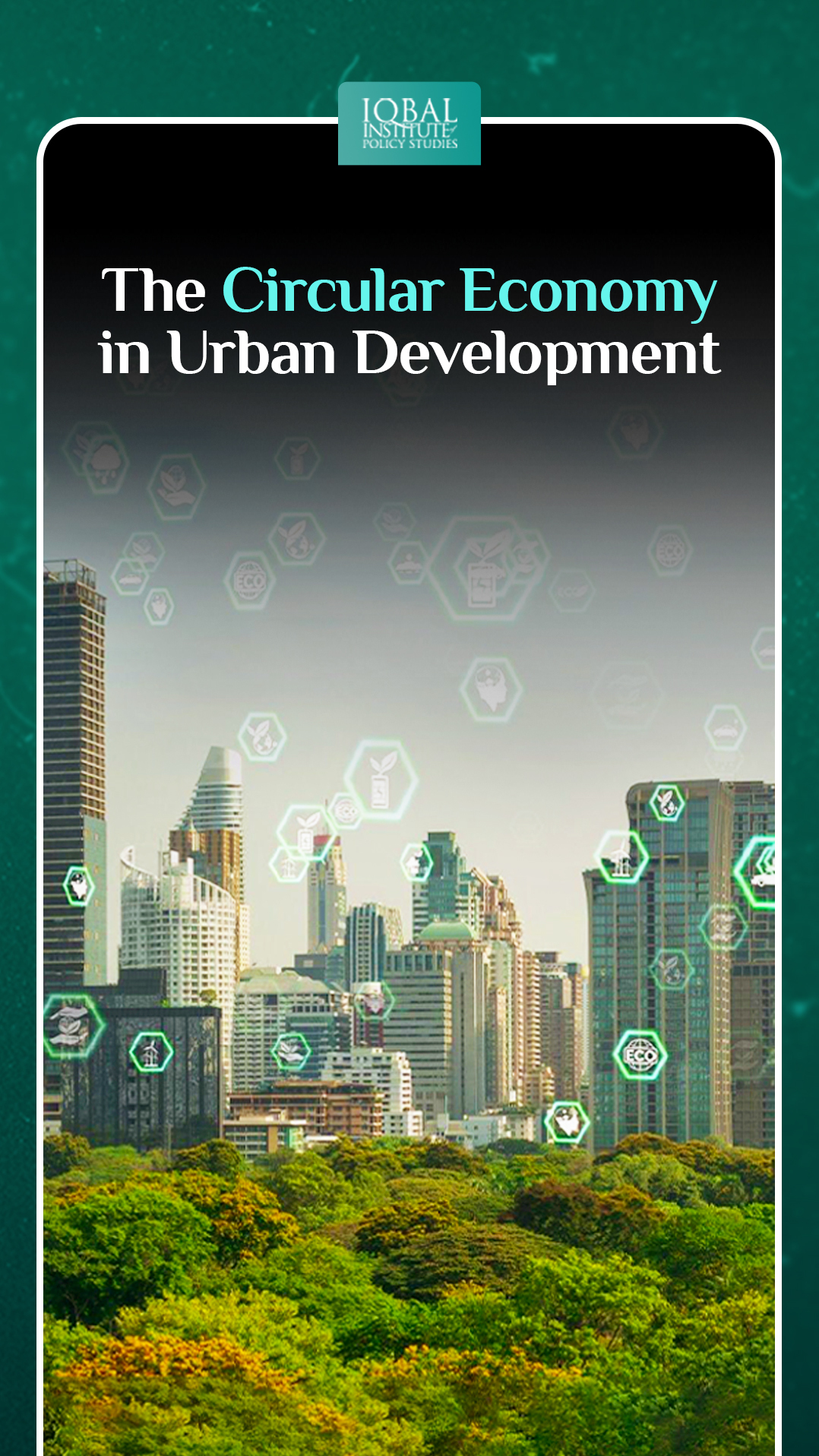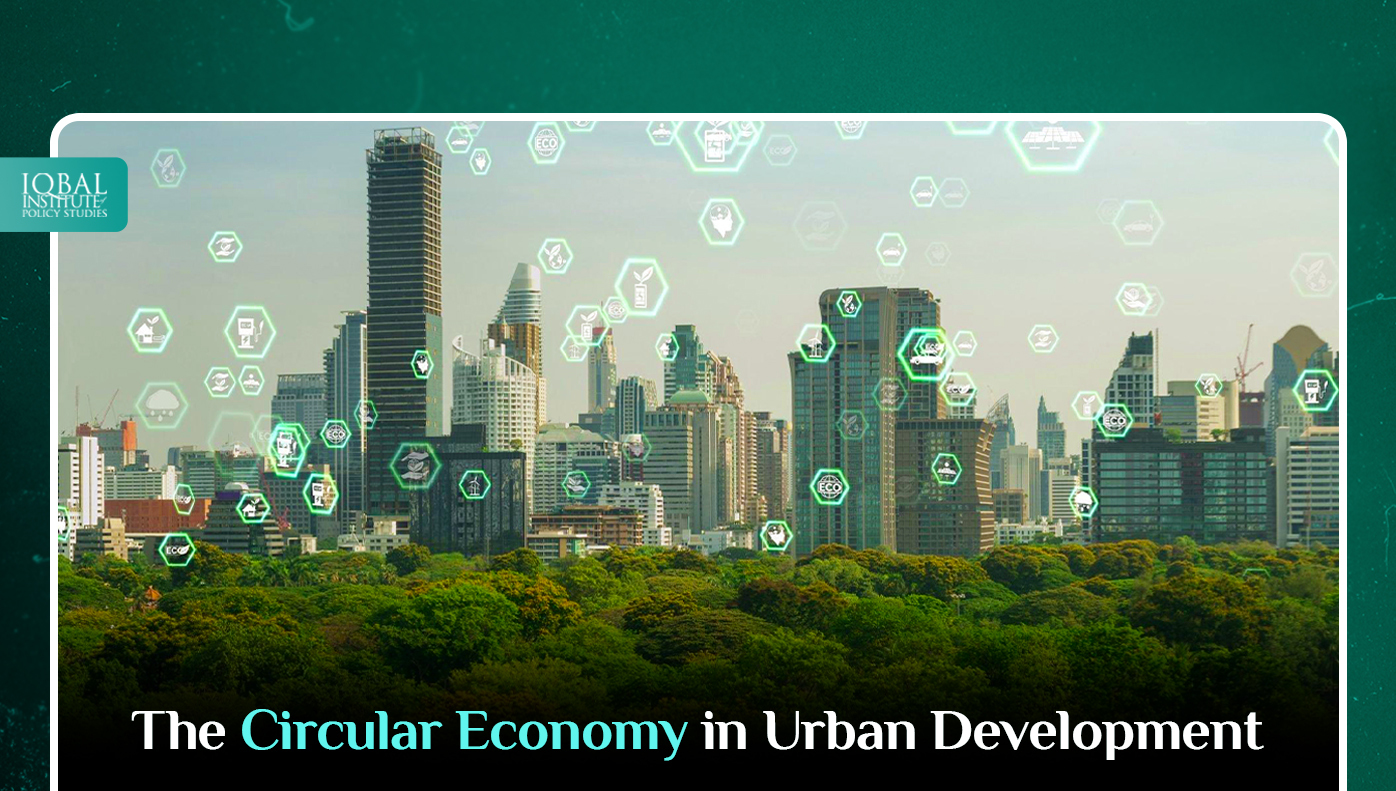The circular economy emerges as a transformative force, offering a sustainable pathway to reshape our cities. Since, urban development stands at a crossroads, facing unprecedented challenges from rapid population growth, strained infrastructure, and environmental degradation; the circular economy represents a departure from the linear “take, make, dispose” model, emphasizing a closed-loop system where resources are reused, recycled, and regenerated. The fundamental principles of reduce, reuse, and recycle guide the circular economy, promoting longevity, resource efficiency, and waste minimization. The benefits extend beyond environmental conservation to encompass economic advantages and positive social impact. Thus, governments must adopt circular economy initiatives by implementing comprehensive policy frameworks that incentivize and mandate sustainable practices. Proactive measures will not only contribute to environmental sustainability but also position governments as leaders in fostering a circular and resilient economy.
The Role of Urban Development in Circular Economy
The role of urban development in fostering a circular economy is pivotal, as cities are both epicenters of resource consumption and hubs of innovation. The traditional linear model of urban development, marked by constant resource extraction, production, and disposal, has proven unsustainable in the face of increasing populations and accelerating environmental concerns. In response, the circular economy introduces a transformative approach that redefines how cities plan, construct, and manage their infrastructure. Urban areas, as engines of economic growth, have the unique potential to lead the charge in circular economy initiatives. By integrating circular principles into the very fabric of urban planning, cities can optimize resource use, reduce waste, and enhance the overall sustainability of their infrastructure.
Furthermore, circular economy practices in urban development encompass a range of strategies, from sustainable construction practices to efficient waste management systems. Concepts such as recyclable building materials, modular design for disassembly, and adaptive reuse of existing structures exemplify the circular approach in shaping urban infrastructure. These initiatives not only contribute to the longevity and adaptability of the built environment but also foster a more resilient and resource-efficient urban landscape. As cities increasingly recognize the interconnectedness of economic, social, and environmental factors, the role of urban development in embracing the circular economy becomes not just a trend but a necessity for creating cities that can thrive sustainably in the long term.
Circular Economy in Urban Infrastructure
Sustainable construction practices, innovative waste management strategies, and water and energy efficiency are key components of applying circular economy principles to urban infrastructure. Concepts like recyclable building materials and modular design for disassembly showcase how cities can create more durable and adaptable structures. Moreover, integrating circular economy principles into waste management systems involves not only recycling but also exploring waste-to-energy initiatives and sustainable water management practices.
Circular Economy in Urban Consumption
Embracing the principles of the circular economy in urban settings necessitates a significant shift in consumer behavior. Cities play a pivotal role in spearheading this change by promoting sustainable lifestyles through innovative models such as the sharing economy and product-as-a-service concepts. Encouraging citizens to participate in plastic-free campaigns and adopting packaging innovations are integral components of this transition. By reducing reliance on single-use items, urban communities can cultivate a culture of responsible consumption, fostering awareness and individual commitment to the principles of a circular economy. This approach not only benefits the environment by minimizing waste but also nurtures a collective consciousness toward sustainable living within the fabric of urban life.
In the pursuit of a circular economy, cities serve as catalysts for transforming individual behaviors. Initiatives that promote sharing economy models and product-as-a-service concepts are instrumental in steering urban consumers towards sustainable choices. Plastic-free campaigns and advancements in packaging contribute to a cultural shift away from disposable habits. These efforts resonate at the grassroots level, fostering a sense of environmental responsibility within urban communities. By emphasizing the reduction of single-use items, cities can weave the principles of the circular economy into the daily fabric of urban living, promoting a more conscientious approach to consumption that aligns with long-term environmental sustainability.
Challenges and Barriers
The transition toward a circular economy, while promising, is not without its challenges and barriers. One significant obstacle is the resistance to change, as individuals and industries may be entrenched in traditional linear models. Convincing stakeholders to adopt new, circular practices requires a concerted effort to showcase the long-term benefits and dispel concerns about potential disruptions. Regulatory obstacles also pose a challenge, as existing frameworks may not align with the principles of a circular economy. Addressing and adapting regulations to accommodate circular practices is essential for creating an enabling environment for sustainable initiatives.
Moreover, economic considerations can act as a barrier to the widespread adoption of circular economy principles. Initial investments in infrastructure and technology required for circular practices may deter businesses and governments from taking the leap. Overcoming these economic hurdles involves developing financial incentives, subsidies, and collaborative funding mechanisms that demonstrate the economic viability and long-term gains of circular approaches. Recognizing and understanding these challenges is pivotal for urban planners, governments, and communities looking to embark on their circular journey. By proactively addressing resistance, navigating regulatory landscapes, and formulating economically sound strategies, stakeholders can pave the way for a smoother and more effective transition to a circular economy in urban settings.
Future Trends and Innovations
Technological advances play a pivotal role, with smart solutions and digitalization optimizing resource use and waste management. Emerging policies aligning with circular principles provide a regulatory framework for sustainable practices, while collaborative efforts between governments, businesses, and communities foster a holistic approach to urban development. Envisioning this future, the narrative unfolds a vision of cities that thrive within the boundaries of a circular and regenerative economy, showcasing a harmonious coexistence with our planet. The trajectory points towards urban spaces that not only embrace circularity but also serve as models of sustainability, demonstrating the potential for innovation to redefine the relationship between cities and the environment.
Conclusion
As urban areas continue to evolve, the adoption of circular economy principles becomes not just a choice but a necessity. By closing the loop, cities can create environments that are not only resilient and resource-efficient but also contribute to a more sustainable and inclusive global future. The circular economy is not merely a concept; it is a roadmap for urban development that leads us toward a more harmonious coexistence with our planet, ensuring the well-being of current and future generations in the ever-growing urban landscape.
This article is written by Haneen Gul. Haneen is a research analyst at the Iqbal Institute of Policy Studies (IIPS).



Leave a Reply